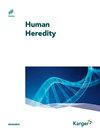Further Evidence for the Implication of the MET Gene in Non-Syndromic Autosomal Recessive Deafness
IF 1.5
4区 生物学
Q4 GENETICS & HEREDITY
引用次数: 5
Abstract
Mutations in the mesenchymal epithelial transition factor (MET) gene are frequently associated with multiple human cancers but can also lead to human non-syndromic autosomal recessive deafness (DFNB97). In the present study, we identified a novel homozygous missense mutation in the METgene causing a non-syndromic hearing impairment DFNB97 form. Whole-exome sequencing was performed to determine the genetic causes of hearing loss in a Moroccan consanguineous family with an affected daughter. The structural analysis of native and mutant in the SEMA domain of the MET receptor was investigated using a molecular dynamics simulation (MDS) approach. We identified a novel pathogenic homozygous c.948A>G (p.Ile316Met) mutation in the MET gene in one deaf Moroccan young girl carrying a total bilateral non-syndromic hearing impairment. The results of the MDS approach show that an Ile316Met mutation in the SEMA domain leads to protein flexibility loss. This may produce a major impact on the structural conformation of the MET receptor, which also affects the function and binding site of the receptor. This is the first time that a mutation in the MET gene is described in a Moroccan family. Moreover, this study reports the second family in the world associating deafness and mutation in the MET gene.MET基因在非综合征性常染色体隐性耳聋中的作用的进一步证据
间充质-上皮转化因子(MET)基因的突变通常与多种人类癌症有关,但也可能导致人类非综合征常染色体隐性耳聋(DFNB97)。在本研究中,我们在MET基因中发现了一个新的纯合错义突变,导致非综合征性听力损伤DFNB97形式。在一个有患病女儿的摩洛哥近亲家庭中,进行了全外显子组测序,以确定听力损失的遗传原因。使用分子动力学模拟(MDS)方法研究MET受体SEMA结构域中天然和突变体的结构分析。我们在一名患有双侧非综合征性听力损伤的失聪摩洛哥年轻女孩的MET基因中发现了一个新的致病性纯合c.948A>G(p.Ile316Met)突变。MDS方法的结果表明,SEMA结构域中的Ile316Met突变导致蛋白质灵活性丧失。这可能对MET受体的结构构象产生重大影响,也影响受体的功能和结合位点。这是第一次在摩洛哥家族中描述MET基因的突变。此外,这项研究报告了世界上第二个将耳聋与MET基因突变联系起来的家族。
本文章由计算机程序翻译,如有差异,请以英文原文为准。
求助全文
约1分钟内获得全文
求助全文
来源期刊

Human Heredity
生物-遗传学
CiteScore
2.50
自引率
0.00%
发文量
12
审稿时长
>12 weeks
期刊介绍:
Gathering original research reports and short communications from all over the world, ''Human Heredity'' is devoted to methodological and applied research on the genetics of human populations, association and linkage analysis, genetic mechanisms of disease, and new methods for statistical genetics, for example, analysis of rare variants and results from next generation sequencing. The value of this information to many branches of medicine is shown by the number of citations the journal receives in fields ranging from immunology and hematology to epidemiology and public health planning, and the fact that at least 50% of all ''Human Heredity'' papers are still cited more than 8 years after publication (according to ISI Journal Citation Reports). Special issues on methodological topics (such as ‘Consanguinity and Genomics’ in 2014; ‘Analyzing Rare Variants in Complex Diseases’ in 2012) or reviews of advances in particular fields (‘Genetic Diversity in European Populations: Evolutionary Evidence and Medical Implications’ in 2014; ‘Genes and the Environment in Obesity’ in 2013) are published every year. Renowned experts in the field are invited to contribute to these special issues.
 求助内容:
求助内容: 应助结果提醒方式:
应助结果提醒方式:


